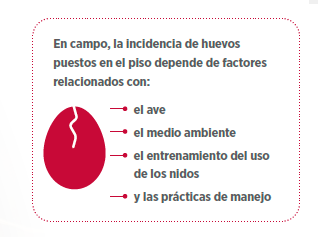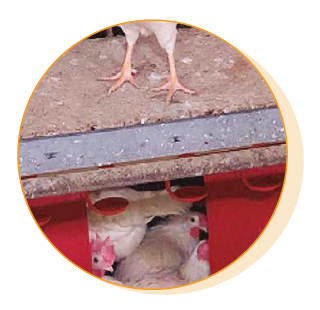Content available at: Español (Spanish)
- Floor Eggs: Management to make layers lay fewer eggs on the floor
Many egg markets have switched to cage-free egg production. In this type of facility, the behavior of the layers in the nests has an important economic characteristic.
- Eggs laid outside the nest are more likely to become contaminated by bacteria from contact with feces and litter.
- Eggs laid outside the nest break easily and are eaten by birds.
- The value of these eggs is lower due to degradation and diversion from egg processing.

Manual collection of eggs from the floor in an aviary is very expensive and a major hassle for egg producers. Eggs laid on the floor can cause increased cloacal cannibalism in the flock which is a problem for animal welfare. It is common in a flock of young layers for the birds to lay a few eggs on the floor while establishing their nest-use behavior.
Generally, the number of eggs laid on the floor will reach a low level in 2–3 weeks. Eggs on the floor are generally in the 1-4% range throughout the life of a layer flock.
BEHAVIOR OF BIRDS IN THE NESTS
It is very important to understand the behavior of the bird in the use of the nests to develop the appropriate programs to minimize the eggs laid on the floor.
- Layer behavior in nests is a complex interplay of genetic, hormonal, behavioral, and environmental factors.
- The layer environment should provide designated nest areas that allow the birds to express their natural instincts to search for the nest to lay eggs.
- Eliminating inappropriate nesting sites within the birds environment is a management challenge.
Behavior before laying
As part of the pre-laying ritual, an hour or two before laying an egg, the hen is restless and begins to explore potential nesting sites. The bird frequently visits sites before choosing the place to nest, on average the bird visits the nest approximately 21.3 times for each egg laid. During these visits, the bird can eat, drink and clean itself as well as express other behaviors. (Photo 1).

Photo 1. The behavior of the birds before laying includes multiple visits to examine nesting sites before selecting the final nest.
After selecting the site, the bird returns several times, exhibiting nest-building behavior. If there is loose material like sawdust, the bird spends more time making the nest. Just before laying the egg, the hen spreads its neck and body feathers.
- Some birds stop to lay the egg.
- The time to lay an egg is variable between 10 and 90 minutes.
- After laying the egg, the hen vocalizes (cackles) and wants to sit on the egg for a while or just leave the nest.
The onset of pre-laying behavior is caused by the last ovulation of the hen (release of the ovarian follicle in the oviduct) and not by the presence of an egg ready to be laid. Previous ovulation releases hormones, estrogen, and progesterone, responsible for the bird’s behavior before laying.
- Any stressful event that elicits a fear response could cause the hen to suspend nest selection and delay laying. If the pre-laying stimulus passes before the egg is laid, then the hen may lose interest in looking for a nest, resulting in more eggs laid on the floor.
Hierarchy Order

- High-ranking birds have the first access to feed, water, and nesting sites.
- Dominant high-ranking birds will occupy the preferred nesting sites excluding birds of a lower rank.
- If the number of preferred nesting sites is limited, then dominated birds may be forced to seek alternative nesting sites, resulting in more eggs laid outside the nests.
Nest preference
Hens prefer comfortable nests in dark, secluded, warm areas.
- Nests with loose material such as wood chips, rice husks, or straw are preferred so that the birds can better express their behavior in building their nests.
- In commercial cage-free production systems, it is common to use nests for automatic collection of eggs, with a rubber mat, (plastic) or artificial grass on the floor of the nest.
Birds prefer nests with solid floors over wire floors. Birds prefer nests located in corners or at the end of lines. They also generally prefer nests in elevated locations compared to nests at ground level. Young inexperienced birds may prefer nests occupied by other hens (gregarious nesting; this behavior tends to decrease with the age of the bird (Photo 2).

In aviary systems, birds will select the most isolated nests located along the wall before using nests located in other parts of the aviary.
Nesting is a learned behavior, but once established, it is difficult to change. Birds tend to return to the same nesting sites every day.
Layers that consistently lay eggs in nests or layers that lay eggs on the floor can be identified in a flock.
For egg producers, the management challenge is to make designated nests attractive to birds and to eliminate alternative nesting sites where birds can lay eggs outside the nest.
Factors Affecting the Incidence of Eggs on the Floor
Behavior of the bird
Keep up to date with our newsletters
Receive the magazine for free in digital version
REGISTRATION
ACCESS
YOUR ACCOUNT
LOGIN
Lost your password?















